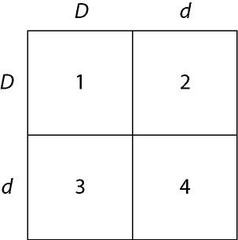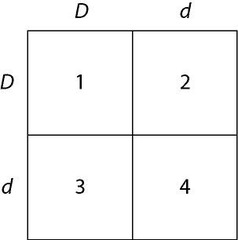Campbell Biology: Chapter 14 Test Prep (Diagrams) – Flashcards
Unlock all answers in this set
Unlock answersquestion
In a particular plant, leaf color is controlled by gene locus D. Plants with at least one allele D have dark green leaves, and plants with the homozygous recessive dd genotype have light green leaves. A true-breeding dark-leaved plant is crossed with a light-leaved one, and the F₁ offspring is allowed to self-pollinate. The predicted outcome of the F₂ is diagrammed in the Punnett square shown in Figure 14.1, where 1, 2, 3, and 4 represent the genotypes corresponding to each box within the square. Which of the boxes marked 1-4 correspond to plants with dark leaves?

answer
1, 2 and 3
question
In a particular plant, leaf color is controlled by gene locus D. Plants with at least one allele D have dark green leaves, and plants with the homozygous recessive dd genotype have light green leaves. A true-breeding dark-leaved plant is crossed with a light-leaved one, and the F₁ offspring is allowed to self-pollinate. The predicted outcome of the F₂ is diagrammed in the Punnett square shown in Figure 14.1, where 1, 2, 3, and 4 represent the genotypes corresponding to each box within the square. Which of the boxes correspond to plants with a heterozygous genotype?
answer
2 & 3
question
In a particular plant, leaf color is controlled by gene locus D. Plants with at least one allele D have dark green leaves, and plants with the homozygous recessive dd genotype have light green leaves. A true-breeding dark-leaved plant is crossed with a light-leaved one, and the F₁ offspring is allowed to self-pollinate. The predicted outcome of the F₂ is diagrammed in the Punnett square shown in Figure 14.1, where 1, 2, 3, and 4 represent the genotypes corresponding to each box within the square. Which of the plants will be true-breeding?

answer
1 & 4 only
question
The following question refer to the pedigree chart in Figure 14.2 for a family, some of whose members exhibit the dominant trait, W. Affected individuals are indicated by a dark square or circle. What is the genotype of individual II-5?

answer
ww
question
The following question refer to the pedigree chart in Figure 14.2 for a family, some of whose members exhibit the dominant trait, W. Affected individuals are indicated by a dark square or circle. What is the likelihood that the progeny of IV-3 and IV-4 will have the trait?

answer
50%
question
The following question refer to the pedigree chart in Figure 14.2 for a family, some of whose members exhibit the dominant trait, W. Affected individuals are indicated by a dark square or circle. What is the probability that individual III-1 is Ww?

answer
1
question
Use the following pedigree (Figure 14.3) for a family in which dark-shaded symbols represent individuals with one of the two major types of colon cancer. Numbers under the symbols are the individual's age at the time of diagnosis. What is the genotype of the deceased individual in generation II?

answer
Heterozygous for a gene for colon cancer
question
Use the following pedigree (Figure 14.3) for a family in which dark-shaded symbols represent individuals with one of the two major types of colon cancer. Numbers under the symbols are the individual's age at the time of diagnosis. In each generation of this family after generation I, the age at diagnosis is significantly lower than would be found in nonfamilial (sporadic) cases of this cancer (~ 63 years). What is the most likely reason?

answer
Hereditary (or familial) cases of this cancer typically occur at earlier ages than do nonfamilial forms
question
Use the following pedigree (Figure 14.3) for a family in which dark-shaded symbols represent individuals with one of the two major types of colon cancer. Numbers under the symbols are the individual's age at the time of diagnosis. From this pedigree, how does this trait seem to be inherited?

answer
As an autosomal dominant
question
Use the following pedigree (Figure 14.3) for a family in which dark-shaded symbols represent individuals with one of the two major types of colon cancer. Numbers under the symbols are the individual's age at the time of diagnosis. The affected woman in generation IV is thinking about her future and asks her oncologist (cancer specialist) whether she can know whether any or all of her children will have a high risk of the same cancer. The doctor would be expected to advise which of the following? I. genetic counseling II. prenatal diagnosis when/if she becomes pregnant III. testing to see whether she has the allele IV. testing to see whether her future spouse or partner has the allele

answer
I and II only



